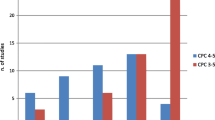Abstract
Prognostication of comatose patients after cardiac arrest presents many challenges. Most clinicians rely upon clinical neurological examination findings to predict outcome. The outcome is usually considered unfavorable when a patient experiences persistent brainstem dysfunction. However, prognostic scales, which rely upon brainstem dysfunction alone, are flawed. Some patients with brainstem dysfunction recover while patients with preserved brainstem function often die without awakening as a result of irreversible destruction of the cerebral cortex.
Access this chapter
Tax calculation will be finalised at checkout
Purchases are for personal use only
Preview
Unable to display preview. Download preview PDF.
Similar content being viewed by others
References
Hockaday JM, Potts F, Epstein E, et al. Electroencephalographic changes in acute cerebral anoxia from cardiac or respiratory arrest: prognostic value of early electroencephalographic findings. Electroencephalogr Clin Neurophysiol 1965; 18: 575–86.
Binnie CD, Prior PF, Lloyd, DSL Scott DF, Margerison JH. Electroencphalographic prediction of fatal anoxic brain damage after resuscitation from cardiac arrest. Br Med J 1970; 4: 265–8.
Goldie WD, Chiappa, KH, Young RR, Brooks EB. Brainstem auditory and short-latency somatosensory evoked responses in brain death. Neurology 1981; 31: 248–56.
Rothstein TL, Thomas EM, Sumi SM. Predicting outcome in hypoxic-ischemic coma. A prospective and electrophysiologic study. Electroencephalogr Clin Neurophysiol 1991; 79: 101–107.
Chiappa KH, Hoch DB. Electrophysiologic monitoring. In: Roper AH, ed. Neurological and neurosurgical intensive care. New York: Raven press, 1993; 147–83.
Madl C, Grimm G, Kramer L, et al. Early prediction of individual outcome after cardiopulmonary resuscitation. Lancet 1993; 341: 855–858.
Young GB, Blume WT, Campbell VM, et al. Alpha, theta, and alpha-theta coma; a clinical outcome study using serial recordings. Electroencephalogr Clin Neurophysiol 1994; 91: 93–99.
Berek K, Lechleitner P, Leuf G, et al. Early determination of neurological outcome after prehospital cardiopulmonary resuscitation. Stroke 1995; 26: 543–549.
Madl C, Kramer L, Yegaehfar W, et al. Detection of nontraumatic comatose patients with no benefit from intensive care treatment by recording sensory evoked potentials. Arch Neurol 1996; 53: 512–16.
Chen R, Bolton CF, Young GB. Prediction of outcome in patients with anoxic coma: A clinical and electrophysiologic study. Crit Care Med 1996: 24: 672–675.
Rothstein TL. The role of evoked potentials in anoxic-ischemic coma and severe brain trauma. J Clin Neurophysiol 2000; 17: 486–497.
Synek VM. Value of a revised EEG coma scale for predicting survival in anoxic-encephalopathy. Clin Exp Neurol 1989; 26: 119–127.
Bassetti C, Bomio F, Mathis J, Hess CW. Early prognosis in coma after cardiac arrest: a prospective clinical, electrophysiological, and biochemical study of 60 patients. J Neurol Neurosurg Psychiatry 1996; 61: 610–615.
Pohlmann-Eden B, Dingethal K, Bender H-J, Koelfen W. How reliable is the predictive value of SEP (somatosensory evoked potentials) patterns in severe brain damage with special regard to the bilateral loss of cortical responses? Intensive Care Med 1997; 23: 301–308.
Snyder BD, Gumnit, RJ, Leppik IE, Hauser MD, Loewenson RB, Ramirez-Lassepas M. Neurologic prognosis after cardiopulmonary arrest: IV. Brainstem reflexes. Neurology 1981; 31: 1092–1099.
Levy DE, Caronna JJ, Singer BH, Lapinski RH, Frydman H, Plum F. Predicting outcome from hypoxicischemic coma. JAMA 1985; 253: 1420–1426.
Jorgenson EO, Malchow-Moller A. Natural history of global and critical brain ischemia. Resuscitation 1981; 9: 133–138.
Mueller-Jensen A, Neunzig HP, Emskotter T. Outcome prediction in comatose patients: significance of reflex eye movement analysis. JNeurol Neurosurg Psychiatry 1987; 50: 389–392.
Brierly, JB, Graham DI, Adams JH, Simpson JA. Neocortical death after cardiac arrest: a clinical, neurophysiological and neuropathological report of two cases. Lancet 1971; 1i: 560–566.
Mullie A, Buylaert W, Michem N, Predictive value of Glasgow coma score for awakening after outof-hospital cardiac arrest. Lancet 1988;i:137–40.
Longstreth WT Jr. Neurological Complications of Cardiac Arrest. In Aminoff MJ, ed. Neurology and General Medicine. New York: Churchill Livingstone, 1994: 166.
Krumholz A, Stern BJ, Weiss HD. Outcome from coma after cardiopulmonary resuscitation: relation to seizures and myoclonus. Neurology 1988; 38: 401–405.
Scollo-Lavizzari G, Bassetti C. Prognostic value of EEG in post-anoxic coma after cardiac arrest. Eur Neurol 26: 161–170, 1987
Pampiglione G, Hardan A. Resuscitation after circulatory arrest. Prognostic evaluation of early electroencephalographic findings. Lancet 1968; 1: 1261–1265.
Prior P. The EEG in acute cerebral anoxia. Assessment of cerebral function and prognosis in patients resuscitated after cardiorespiratory arrest. Amsterdam: Excerpta Medica, 1973.
Bassetti C, Karbowski K. Prognostic value of electroencephalography in non-traumatic comas. Schweiz Med Wochenschr1990; 120: 1425–1434.
Young GB, Kreeft JH, McLachlan RS, Demelo J. EEG and clinical associations with mortality in comatose patients in a general ICU..1 Clin Neurophsyiol 16: 354–360, 1999.
Attia J, Cook DJ. Prognosis in anoxic and traumatic coma. Crit Care Clin 1998; 14: 497–511.
Wijdicks EFM. The diagnosis of brain death. NEngl JMed 2001; 344: 1215–1221.
Walker, AE. Cerebral death. Dallas: Professional Information Library, 1977
Silverman D, Saunders MG, Schwab RS, Masland RL. Cerebral death and the electroenceophalogram. Report of the ad hoc committee of the American Electroencephalographic Society on EEG criteria for determination of cerebral death. JAMA 1969; 209: 1505–1510.
Moller M, Holm B, Sindrup E, Nielson BL. Electroencephalographic prediction of anoxic brain damage after resuscitation from cardiac arrest in patients with acute myocardial infarction. Acta Med Scand 1978; 203: 33–37.
Author information
Authors and Affiliations
Editor information
Editors and Affiliations
Rights and permissions
Copyright information
© 2004 Springer Science+Business Media New York
About this paper
Cite this paper
Rothstein, T.L. (2004). Recovery from near Death Following Cerebral Anoxia. In: Machado, C., Shewmon, D.A. (eds) Brain Death and Disorders of Consciousness. Advances in Experimental Medicine and Biology, vol 550. Springer, Boston, MA. https://doi.org/10.1007/978-0-306-48526-8_17
Download citation
DOI: https://doi.org/10.1007/978-0-306-48526-8_17
Publisher Name: Springer, Boston, MA
Print ISBN: 978-1-4757-0976-6
Online ISBN: 978-0-306-48526-8
eBook Packages: Springer Book Archive




